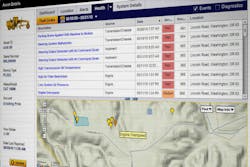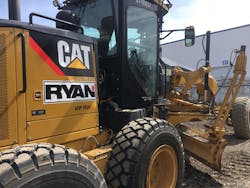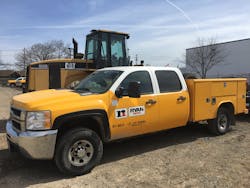For all the good that telematics data can do for fleet managers, there are always the issues of too much information, how to decide what’s most important to know, and identifying who needs to know it. Contractor Ryan Central wanted to master the prioritization and analysis of real-time and near real-time fault codes from a myriad of machine makes and models.
“Our fleet is about 500 units, and about 425 have an engine,” equipment manager Aaron Mayer says. “Sixty-five to 70 percent of our fleet has a [telematics] device on it.”
With that size mixed fleet, and different manufacturers managing cellular data usage differently—some communicate in real time while others communicate four times a day—it adds up to a substantial stream of data. The fault codes alone can be overwhelming on hot, dusty days with a couple hundred machines in the field.
“There’s a lot of noise,” Mayer says.
The challenge for Mayer and Ryan Central has been to definitively sort out what is critical machine-in-jeopardy information, what might cause a failure down the line, and finally, what’s left.
The Janesville, Wisconsin-based earthmover and former Construction Equipment and AEMP Fleet Masters award winner has established three levels of alert profiles for each of its machine categories. There’s high severity, medium severity, and a third level that Mayer jokingly named “Noise.”
As far as which codes deserve which levels, the manufacturers themselves are helpful, to a point.
“For example, take a Caterpillar machine, they’ve gone through and identified what they think are the high-severity, medium-severity, and low-severity codes, so that’s kind of a baseline,” Mayer says.
How to filter fault codes
But over time, experience has had to help refine the profiles. “Through receiving alerts over a long period of time you begin to see which ones matter and which ones don’t,” Mayer says. “For example, on a Cat 627G scraper, every day you will get a low air pressure code because the 627 has two engines. As soon as the first engine starts up, it throws an error for low air pressure on the back. With time, you realize these kinds of things and filter them out.”
Ryan Central also had to decide who receives what information to turn the alerts into action. “For high-severity alerts, such as an engine overheat or oil pressure, these would immediately go to the maintenance manager in the region that machine’s working so they can react to it immediately,” Mayer says.
The second level, medium severity, is anything that is not an immediate machine-down possibility but still merits scrutiny.
“Medium severity for us, it’s not a safety thing, but it’s something that could potentially result in kind of unexpected machine downtime,” Mayer says. “If it’s a medium-severity alert, it would go to the maintenance manager as well as our reliability manager who’s at our headquarters. He basically has visibility to all the repair history and fluid sample analysis, and he can see what kind of job it’s working on. He’ll try to ascertain whether it’s something we should act on or not. And if it’s something we should act on, he would issue a work order.”
It’s obvious that following the high-severity alert profile procedures has prevented machine failures, but Mayer says it’s surprising how many failures have been prevented by examining medium-severity alerts. They are the kind of codes that may not attract an operator’s attention or could be disregarded.
“You might have something like a sensor that keeps tripping, where in the past it might have been perceived as a nuisance, but now our reliability manager goes in and he can look at the fault code/error alert history on that machine, he can compare it to similar machines, look at the maintenance history, and then look at the fluid sampling analysis,” Mayer says.
“Looking at the fluid sample analyses, if this is transmission-related for instance, he might notice that in the elemental analyses iron or aluminum has been climbing and we realize something’s slowly creating this metal,” he says. “We would opt to take that machine out of service, schedule it, and investigate the applicable component or compartment to see what’s happening.
“We’ve had these on some of our medium- and large-sized dozers,” Mayer says. “In transmissions, for instance, we’ve been able to identify a problem in advance and take it out of service. The repair ended up costing $15,000 to $20,000, but had it failed catastrophically, it would have been about $60,000, plus lost production and being unable to control when it was fixed.”
Ryan has seen other benefits from prioritizing fault codes for action, including improvements in the efficiency of its mechanics.
“Everybody in the industry knows there’s been a shortage of mechanics,” Mayer says. “In the past, before telematics, you might have an issue on a machine, the operator sees an error or a fault code come up on a monitor, he calls the maintenance manager, who tells the mechanic, and they might go look at it, troubleshoot it, and have to drive to get a part and come back,” Mayer says.
“Today, we’re trying to use those error alerts to identify with a high probability what we think it is,” Mayer says “So when we make a call for a mechanic, whether it’s our mechanic or a dealer service call, they can have those parts. We now know that if this certain error alert went off, there’s an 80 percent chance it’s a starter, or a battery, or this wiring harness; so they can make sure it’s on the truck when the technician responds. It’s a one-trip fix instead of a two-trip fix. We’re better utilizing technicians, whether they’re ours or not.”
With the continuing shortage, the techs a company does have can’t be wasting time. Mayer and Ryan Central continue to discover more advantages as more codes become available. “The breadth of information you can get from a machine is increasing,” he says. “Where 10 years ago there may have been 30 or 40 available alerts, now there are hundreds.
“Safety is an absolute priority for us and one of the alerts we’re getting now is seat belt usage,” Mayer says. “With some new machines, we’ve been getting alerts where the machine’s started and is put in gear and the seat belt is not engaged. So we’re able to quickly identify and zero-in on those instances. It can be hard to tell if someone’s wearing a seat belt from the ground. We’re trying to use that data to correct behavior immediately. Safety alerts such as this are our highest-severity alerts.”
New alerts on new models are also targeting operator behavior once the machine is in gear (see our exclusive Field Test of the Volvo L180H wheel loader in the March issue or at ConstructionEquipment.com/L180H).
“When we get a new type of machine, we get [every alert] and you have to gradually parse it back so only the critical operator error or abuse alerts are coming through,” Mayer says. “If someone’s engaging the parking brake before the machine stops, or shifting the transmission while the machine’s moving, we want to identify these issues so we can go out and coach someone to operate a machine more efficiently, which increases productivity and reduces downtime and repair costs down the road.”
Ryan Central outsources code analysis for its newer Volvo machines, using Volvo’s ActiveCare Direct service. “We were one of the first fleets to test it, and the reason we did it is that they presented it as they’re going to have this group of subject matter experts who are going to receive all these alerts, and because of the huge [machine] population and their intimate knowledge of those machines, they’re able to parse through all that data and relay only actionable items to the [Volvo] dealer,” Mayer explains.
Mayer also found the concept attractive because of the frustrations of having to filter through the new codes on new equipment. “Every time a new machine would come out, you’d have to go through and reset the [alert] profile and it would take a season or two to zero-in on which alerts were material and which weren’t, and it was very time consuming,” he says.
“Again, we just had a lot of noise,” Mayer says. “So what ActiveCare does is take your fleet, identify the dealers that you’re working with and which machines are working within those dealer territories, and as the alerts are generated, they go to ActiveCare [at Volvo’s Shippensburg, Pennsylvania, headquarters] and Active-Care decides if it’s actionable or if it’s noise. If it’s noise, it doesn’t get forwarded on [to a Volvo dealer].”
In the ActiveCare model, the dealer is responsible for reaching out to Ryan Central to advise and schedule service, or determine if it’s something the contractor wants to handle in-house. Ryan works with several Volvo dealers across the eastern half of the U.S. Volvo also follows up with the dealers to make sure there has been a response. Mayer is pleased with the model so far.
“They learn the data quicker than we do because of the machine population,” he says. “We might look at 100 of something, they’re looking at thousands. We think it’s great because there’s another set of truly expert eyes looking at this data, and we’re getting a lot less noise. When we get communications by telematics from our Volvo equipment we know it’s important, so we’re acting on it.”
The medium-severity alerts are a little trickier.
“The medium-severity stuff, through Volvo, they don’t have visibility to our fluid sampling analysis,” Mayer says. “They don’t have visibility to our repair history. They know what the machine is, they can see the warranty repair history and obviously the aggregate data for machines of that type. We also know what application the machine’s operating in; they don’t know that.
“In a perfect world, they would have visibility to all of that,” Mayer says. “It’s tough, because you would either have to use their oil sampling lab and their dealers exclusively for all service, or find a way to standardize this type of data and share it with them. The first option isn’t feasible and the second would be difficult.”
About the Author
Frank Raczon
Raczon’s writing career spans nearly 25 years, including magazine publishing and public relations work with some of the industry’s major equipment manufacturers. He has won numerous awards in his career, including nods from the Construction Writers Association, the Association of Equipment Manufacturers, and BtoB magazine. He is responsible for the magazine's Buying Files.



